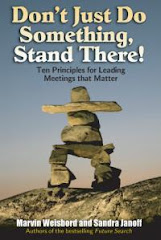A friend said he wanted to recommend Future Search (our collaborative planning process) for team-building with a 15-person work group.
Here's our reply--
Sandra and I are delighted you want to recommend FS for this purpose. However, what we would like you to tell these folks is that although their meeting cannot be an actual Future Search, the techniques used in Future Search (e.g. mind map, time lines) could be useful team-building tools.
You also could point out that two of the four FS principles can be used successfully in team-building: (3) focus on the future/ common ground (problems and conflicts as information, not action agendas); and (4) self-managing their own small group discussions, generating their own data, and drawing their own conclusions. (If they use an outside consultant, they would need somebody who knows how to work this way, rather than a consultant who interviews and organizes the data for them.)
The first two principles would NOT apply, thus making it impossible to do an FS. You will not have (1) the "whole system in the room," since those who constitute the team's environment, e.g., customers, suppliers, other functions, are not present. Therefore, you also can't (2) "explore the whole elephant," since you only have the head and the trunk. The first two are the defining principles of FS. They make systems thinking experiential, bringing the environment into the room. System transformation occurs only when you change a system's relationships to the larger system of which it is a part. In team building all you can change are the relationships of team members to each other and to the boss.
--Marv Weisbord
Thursday, April 30, 2009
Monday, April 27, 2009
Making Stress While the Sun Shines
Having for the second time in 20 years spent nearly 3 days with 86 people from 20 countries in a windowless, poorly-lighted hotel ballroom with an inadequate sound system I hereby testify that such rooms may serve candle-lit banquets but are harmful for serious work. The meeting was vital to the health care of third world countries. Given a deadline, we had no choice of rooms. And people, a tribute to their commitment, worked with good humor, intelligence and extraordinary patience under intolerable conditions. It was a non-stop battle against an environment that we could, with a little forethought, control. You could say we compromised our own short term well being for the long-term sake of those in greater need. But why? If I were king, I’d declare hotel dungeon rooms off limits for serious meetings. Since I’m a commoner, I beg my fellow citizens to rebel against dungeon rooms given the persuasive evidence that people ought not meet like this. Don’t rely on my prejudices. Check out the vast literature on the centrality of natural daylight to human health. Still, some people choose to work in the dark ages. I’m done with it folks. This time I really mean it!
Here are two items from last Sunday's paper that stiffen my resolve--
A team of University of Washington researchers put 50-inch TV screens showing a live view of nature into windowless faculty offices. “People liked this,” said the writer. “but in another study that measured heart-rate recovery from stress, the HDTV’s were shown to be worthless, no better than staring at a blank wall. What did help with stress was giving people an actual plate-glass window looking out upon actual greenery.”
--Bloom, Paul. “Natural Happiness.” The New York Times Magazine, April 19, 2009, pp. 11-13.
And from the same magazine, bottom of page 35--
“18 Average reduction in stay, in hours, at a suburban Pennsylvania hospital for patients recovering from gallbladder surgery whose window faced trees rather than a brick wall, according to a study in 1984 (Science magazine).”
--Marv Weisbord
Here are two items from last Sunday's paper that stiffen my resolve--
A team of University of Washington researchers put 50-inch TV screens showing a live view of nature into windowless faculty offices. “People liked this,” said the writer. “but in another study that measured heart-rate recovery from stress, the HDTV’s were shown to be worthless, no better than staring at a blank wall. What did help with stress was giving people an actual plate-glass window looking out upon actual greenery.”
--Bloom, Paul. “Natural Happiness.” The New York Times Magazine, April 19, 2009, pp. 11-13.
And from the same magazine, bottom of page 35--
“18 Average reduction in stay, in hours, at a suburban Pennsylvania hospital for patients recovering from gallbladder surgery whose window faced trees rather than a brick wall, according to a study in 1984 (Science magazine).”
--Marv Weisbord
Subscribe to:
Comments (Atom)
.jpg)
